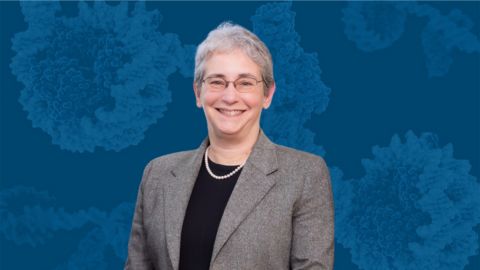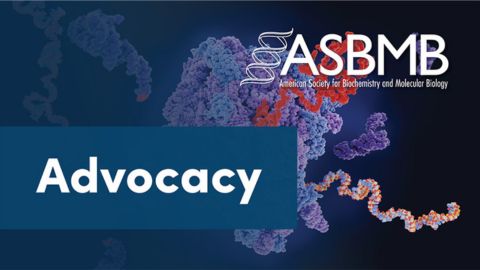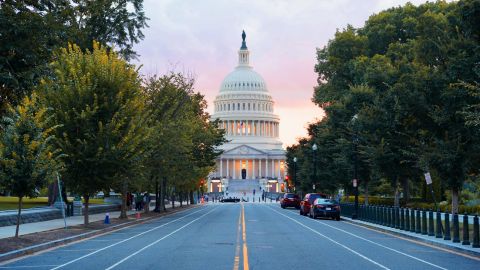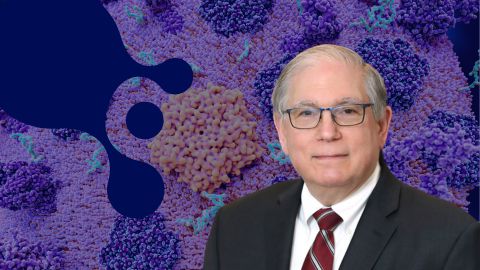Gain-of-function research: All in the eye of the beholder
In 2012, the National Institutes of Health (NIH) organized a meeting after two laboratories independently reported eye-opening results. In both labs, researchers had managed to alter the avian H5N1 flu virus so it could spread through the air among ferrets, an animal often used in virology to model the development and spread of pathogens in mammals. This particular flu virus kills 60 percent of the humans it infects, but the virus’s spread is limited to those who eat or handle infected poultry. The new lab-altered viruses, on the other hand, had been mutated in ways that allow them to spread on air droplets like seasonal flu.

particles (orange) found near an infected cell (green). Image captured
and color-enhanced at the NIAID Integrated Research Facility in Fort
Detrick, Maryland.
At the NIH meeting, researchers applied a new term — gain-of-function — to this type of high-risk research, which can have the effect of making viruses more deadly, more transmissible, or otherwise more able to flourish. Proponents say this research is essential for developing new therapies and vaccines and understanding how viruses cause pandemics. But critics say any insights from these experiments aren't worth the risk of a lab-created virus reaching the outside world. The debate has only grown more heated in the context of this current pandemic, with some asking whether SARS-CoV-2 could have escaped from the Wuhan Institute of Virology in China, where researchers studied coronaviruses.
During Congressional hearings in May and July, Sen. Rand Paul of Kentucky accused the NIH and Anthony Fauci, the long-time director of the NIH’s National Institute of Allergy and Infectious Diseases (NIAID), of supporting the Wuhan facility’s studies, which Paul claimed were in violation of a temporary federal pause on gain-of-function research funding announced in 2014. Fauci denied the experiments in question were, in fact, gain-of-function — a response that prompted Paul to retort that he was "trying to obscure responsibility for 4 million people dying around the world from a pandemic."
There’s no evidence NIH-funded research sparked the pandemic. But the dispute underscores widespread confusion surrounding gain-of-function research, which is now a flashpoint in the broader debate over lab experiments with dangerous viruses. That Paul and Fauci could arrive at such different conclusions about the same work gets to the heart of a thorny problem: When it comes to gain-of-function research, “no one agrees on what it is,” says Nicholas Evans, an associate professor of philosophy at the University of Massachusetts, Lowell, who specializes in biosecurity and pandemic preparedness.
In the most basic sense, gain-of-function, or GOF, research refers to the introduction of a mutation that enhances a gene's functional properties — farmers have arguably practiced it for thousands of years through plant breeding. But definitions applied in virology have also narrowed over time, such that some researchers now maintain that in the strictest sense of the term — increasing virulence or transmissibility in humans — "no GOF experiments have been performed," says Stanley Perlman, a virologist at the University of Iowa.
Absent consensus, public views on gain-of-function are vulnerable to polarized rhetoric, and policy makers continue to struggle with how to regulate the research. "No one knows exactly what counts as gain-of-function, so we disagree as to what needs oversight, much less what that oversight should be," Evans says.
During the H5N1 research, Ron Fouchier, from Erasmus University Medical Center in Rotterdam, the Netherlands, and Yoshihiro Kawaoka, from the University of Wisconsin, Madison and the University of Tokyo, both virologists, wanted to understand how pandemic flu viruses might evolve. Working in biosafety level-3 labs used for studies of dangerous pathogens that might transmit through the air, they used a variety of techniques to alter the virus' genome, introducing changes that altered its behavior. The results from both labs showed that with only a few gene mutations, H5N1 could become an airborne spreader in mammals without having to go through the typical process of combining with other viruses in an intermediate host, such as a pig or rodent.
Although the changes to the virus also appeared to make it less virulent — none of the ferrets infected with the viruses through the air died — the finding confirmed that H5N1 poses a pandemic threat; it also created an international uproar, and many scientists were divided over the experiments. Some expressed support. Fauci, for instance, during a press conference marking publication of the Fouchier paper, acknowledged the possibility that a scientist working with an altered virus might become infected, causing an outbreak or even a pandemic.
Still, the benefits of "stimulating thought and pursuing ways to understand better the transmissibility, adaptation, pathogenicity” of H5N1, he added, "far outweigh the risk." Others accused Fouchier and Kawoaka of being reckless, prompting the two virologists and their colleagues to agree to a temporary moratorium on the research.
Then in 2014, in the wake of a series of biosafety incidents involving microbiology experiments at U.S. government facilities, including one in which samples of a relatively benign avian flu virus were inadvertently contaminated with H5N1 by influenza researchers at the Centers for Disease Control and Prevention, the NIH announced a pause on new funding for gain-of-function studies. According to the U.S government’s phrasing, the pause was specifically directed at "gain-of-function research projects that reasonably may be anticipated to confer attributes to influenza, MERS [Middle East Respiratory Syndrome], and SARS [Severe Acute Respiratory Syndrome] viruses such that the resulting virus” is either more deadly or better able to spread in mammals.
In all, 18 laboratories were affected. Their new grant funding was frozen, and researchers in these labs were asked to put their gain-of-function work on hold while a team of experts undertook what became a three-year effort to craft new federal oversight policies.
During this time, however, and with Fauci's approval, the NIAID continued to supply funding to the Wuhan investigators, who were trying to predict where the next coronavirus outbreak might come from. During his July spat with Fauci, Paul singled out a 2017 research paper co-authored by Peter Daszak, president of the EcoHealth Alliance, a New York-based nonprofit group through which the NIAID money was channeled. (EcoHealth's press officer, Robert Kessler, declined to make anyone available for an interview, and said in an email: "We've not conducted gain-of-function research, so aren't really good authorities to speak on the subject.")
Over the course of the five-year project, the investigators took fecal samples from cave bats in Yunnan, China, about 1,000 miles southwest of Wuhan, and isolated close relatives of the coronavirus that causes SARS. Then, using a method called reverse genetics, they attached surface "spike" proteins from those newly identified microbes to a different SARS-like coronavirus called WIV1. (Coronaviruses, including SARS-CoV-2, use their spikes to attach to other cells and initiate an infection, but for these experiments the researchers used an engineered form of WIV1 that lacked spike proteins of its own).
Daszak and the Wuhan team wanted to know if these lab creations — called chimeras — could infect human airway cells. As it turned out, several could, which suggested that natural coronaviruses outfitted with the the same spikes used in making the chimeras might also be able to infect people. This information, the team concluded presciently, "highlights the necessity of preparedness for future emergence of SARS-like diseases."
Citing this research, Paul said that the Wuhan scientists had manipulated coronaviruses that only infect animals in nature so that they "gain the function of infecting humans." These experiments, he claimed, "fit the definition of the research that the NIH said was subject to the pause." Fauci disagreed, countering that the Kentucky senator, long a thorn in the side of federal agencies working on Covid responses, did “not know what he was talking about.”
So who was right? There is no consensus within the research community. The NIAID declined to make Fauci or anyone else available to Undark for an interview, but embedded in Paul's argument are two points of contention among scientists. One is the question of whether the backbone virus, WIV1, fits within any of the three viral categories specified in the pause.
WIV1 is about 90 percent genetically similar to the virus that causes SARS disease in people, but it is not a SARS virus per se. Richard Ebright, a molecular biologist at Rutgers University and a staunch critic of gain-of-function research, claimed in an email to Undark that the pause was "expressly intended by policy makers to refer to clades (e.g., groups) of viruses, and not a single virus." Seen this way, WIV1, being in the SARS-like clade, would have been subject to the pause's funding restrictions.

particle covered in red spike proteins (background). Researchers at the Wuhan
Institute of Virology were able to substitute a spike protein isolated from
a SARS-like virus found in bats onto a different virus called WIV1.
When Undark asked NIAID to comment, media relations staff replied by email that the pause applied specifically to "all influenza viruses as well as two specific coronaviruses: MERS and SARS-CoV-1 [which is a more precise term for the virus that causes SARS]." When Undark put that response to Ebright, he responded that the NIAID was "lying, brazenly" since the actual 2014 policy language never made this distinction. Susan Weiss, a microbiologist who works with coronaviruses at the University of Pennsylvania, points out that "there's the letter of the law and the spirit of the law," but as to which applies in this debate, she adds, "I don't know."
The second point of contention is whether the chimeras generated in Wuhan were enhanced in ways that made them more deadly or transmissible than WIV1 itself. WIV1 in its natural, unmodified form already infects human cells in a dish, so replacing its own spikes with those from other coronaviruses adds no gain of function in that respect. Still, some chimeras were more pathogenic in exposed mice than unmodified WIV1, according to experimental summaries obtained and published by The Intercept on Sept. 9, as part of its ongoing Freedom of Information Act litigation against the NIH: “Three chimeras produced 10,000 times more virus in the mice’s lung tissue than unmodified WIV1, and one caused the mice to lose significant weight.”
According to the grant's stipulations, the researchers at that point should have ceased the experiments. But The Intercept reported that the NIH concluded the restrictions on GOF research did not apply in this case, and there is no evidence that the research was stopped. Whether the chimeras would also be more pathogenic in people is unclear. No WIV1 infections in people have been reported, so its ability to spread and cause disease among humans is also unknown. Perlman says that just because the virus and its engineered chimeras infect isolated human cells in a petri dish does not mean they can infect cells in an actual person, where viruses are subject to immune defenses and other challenges.
In 2017, after deliberating during the three years of the pause, the U.S. Department of Health and Human Services, which oversees the NIH, produced an oversight system that didn't even mention gain-of-function. Called the PC30 Framework, the system focused instead on how and whether to fund projects on so-called "enhanced potential pandemic pathogens," or PPPs. Where the pause was limited to influenza, MERS, and SARS viruses, the PC30 Framework had a broader scope: PPPs could include any highly transmissible pathogen that can spread uncontrollably and cause widespread human disease and death. Enhanced PPPs were defined as having been altered to become even more transmissible and deadly. (Natural pathogens either circulating in nature or recovered from it were excluded from the policy, as were efforts to sequence pathogens or use them to make vaccines.)
A committee at the Department of Health and Human Services is now tasked with making final decisions about what is and is not a gain of function experiment. But longtime critics of federal oversight still aren't pleased. Ebright claims that apart from two projects carried over from prior to 2017 — the Fouchier and Kawaoka research on H5N1 — there are no public records of any reviews being performed, suggesting that "the NIH doesn't flag projects for review, nullifying the policy."
Arturo Casadevall, a microbiologist at the Johns Hopkins Bloomberg School of Public Health, co-authored a 2020 editorial in the journal mBIO, reporting that both PC30 reviews to date have been made behind closed doors, despite guidance from the White House at the time the framework was released encouraging a transparent process.
Transparency could ensure that reviewers are free of conflicts of interest. But given the politics surrounding gain-of-function, the possibility that others may use public information for nefarious purposes, and the way researchers associated with gain-of-function have been attacked in the press and on social media, transparency might also deter potential reviewers from participating. In an email to Undark, Casadevall acknowledged that "some people in the coronavirus field have gotten death threats." Still, he added, "it should possible to open the documents and conclusion of the review while shielding the reviewers. This is what we do in an academic literature peer review."
The broader public was recently offered a glimpse of peer review when a quasi-anonymous group of self-described “Twitter detectives” released a grant proposal EcoHealth submitted to the Defense Research Projects Agency (DARPA) in early 2018. EcoHealth and its partners, which included the Wuhan Institute of Virology, wanted to inoculate wild bats in China with proteins from chimeric coronaviruses, reasoning that vaccinated bat immune systems would block viral replication and thus lessen the risk of the virus spilling over into local populations. According to the leaked documents, whose authenticity has only been indirectly verified, DARPA rejected the $14 million proposal, in part over concerns that the way the researchers proposed to engineer the viruses would put it in the GOF category.
Gain-of-function research accounts for just a tiny sliver of the federal research portfolio, and the scientists who spoke with Undark were hard pressed to identify many important discoveries made through this line of research.
Casadevall cited the work of Fouchier and Kawaoka, which, he says, showed unequivocally that H5N1 had the capacity of airborne spread among mammals. "You could not have learned by any other experiments," he says. "Now we know that humanity faces a huge threat from all this bird flu; it just hasn't happened yet." And some pointed to the work of Ralph Baric, a virologist at the University of North Carolina, who pioneered the experimental techniques used in Wuhan.
Through a spokesperson, Baric declined to be interviewed for this article, citing a request from his university that he refrain from speaking to the press. Yet in a recent interview with MIT Technology Review, he claimed that this experimental method was instrumental in allowing him to identify high-risk SARS-like coronaviruses and test drugs against them. Fauci asserted in a 2012 editorial that the need to stay ahead of pandemic threats is the primary justification for gain-of-function research. However, Simon Wain-Hobson, a microbiologist at the Pasteur Institute in Paris, counters that "no one can predict the next pandemic, and if you can't do that, then the whole raison d'etre for gain-of-function falls apart."
Jesse Bloom, an evolutionary biologist who works on virology at the Fred Hutchinson Cancer Research Institute, agrees. "When you talk about an experiment in which the consequences of an accident are a global pandemic — it's really hard to even put that into a risk-benefit analysis," he says. SARS-CoV-2, he added, emerged in Wuhan "right under the noses of people doing this work, and nothing they did was useful in stopping it."
For his part, Casadevall steers towards the middle ground, and worries that if society overreacts against gain-of-function research, the field might become over-regulated, and then the experiments will never get done. "Not all pathogens have the same pandemic potential," he says. "And it would be really good if humanity knew which ones are more dangerous."
This article was originally published on Undark. Read the original article.
Enjoy reading ASBMB Today?
Become a member to receive the print edition four times a year and the digital edition monthly.
Learn moreGet the latest from ASBMB Today
Enter your email address, and we’ll send you a weekly email with recent articles, interviews and more.
Latest in Policy
Policy highlights or most popular articles

Hope for a cure hangs on research
Amid drastic proposed cuts to biomedical research, rare disease families like Hailey Adkisson’s fight for survival and hope. Without funding, science can’t “catch up” to help the patients who need it most.

Supporting science through advocacy and community building
ASBMB calls on scientists to take action as funding cuts and policy shifts threaten the U.S. research enterprise, emphasizing the power of community advocacy and persistence in protecting the future of science.

Seven steps to advocating in your home state
Find out how to schedule, prepare for and conduct a productive district office meeting to communicate the importance of fundamental scientific research funding to your representatives.

ASBMB members call for funding and agency support amidst uncertainty
In 60 meetings on Capitol Hill, scientists urge legislators to reaffirm support for scientific innovation

Embrace your neurodivergence and flourish in college
This guide offers practical advice on setting yourself up for success — learn how to leverage campus resources, work with professors and embrace your strengths.

ASBMB honors Lawrence Tabak with public service award
He will deliver prerecorded remarks at the 2025 ASBMB Annual Meeting in Chicago.

